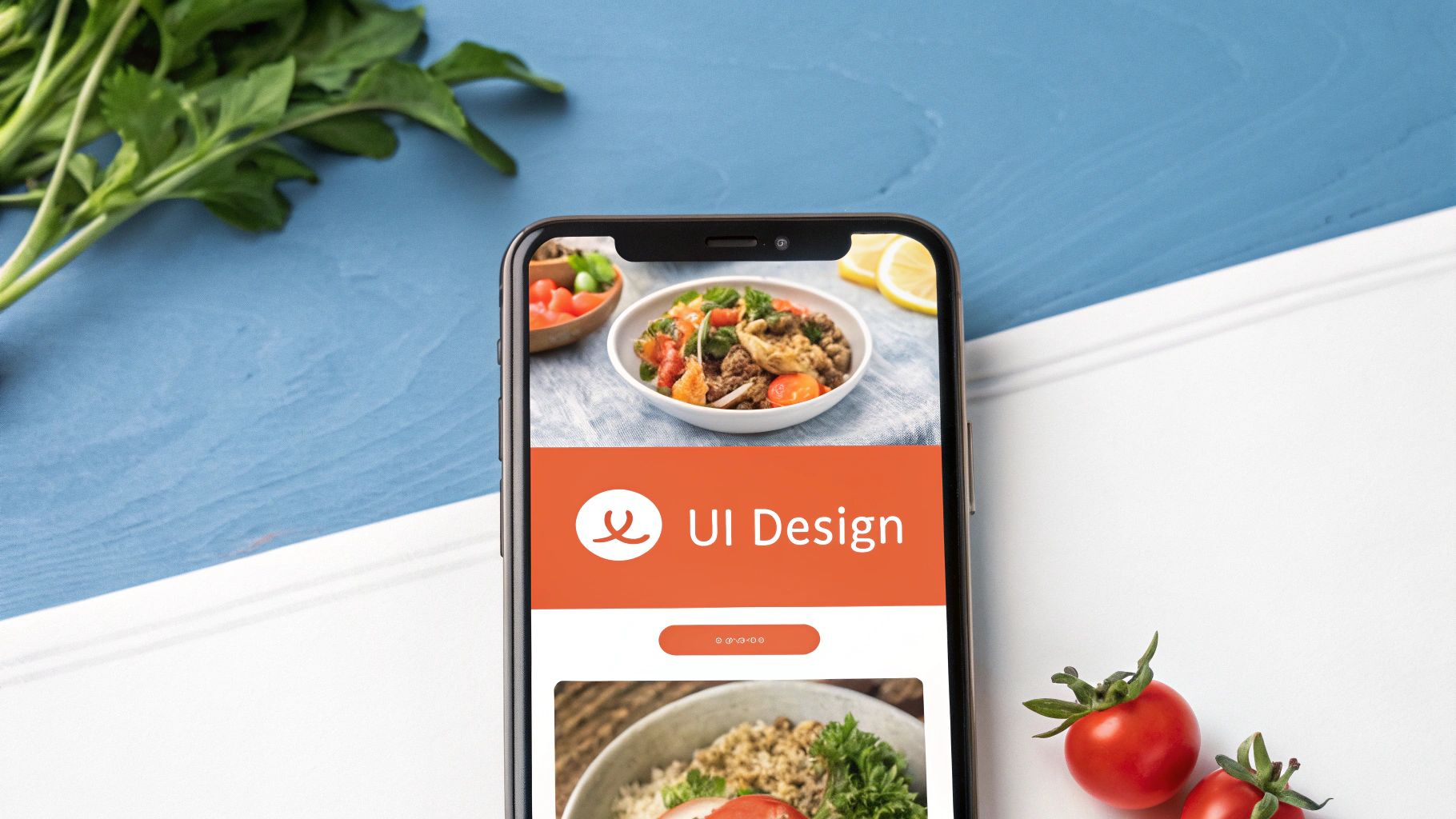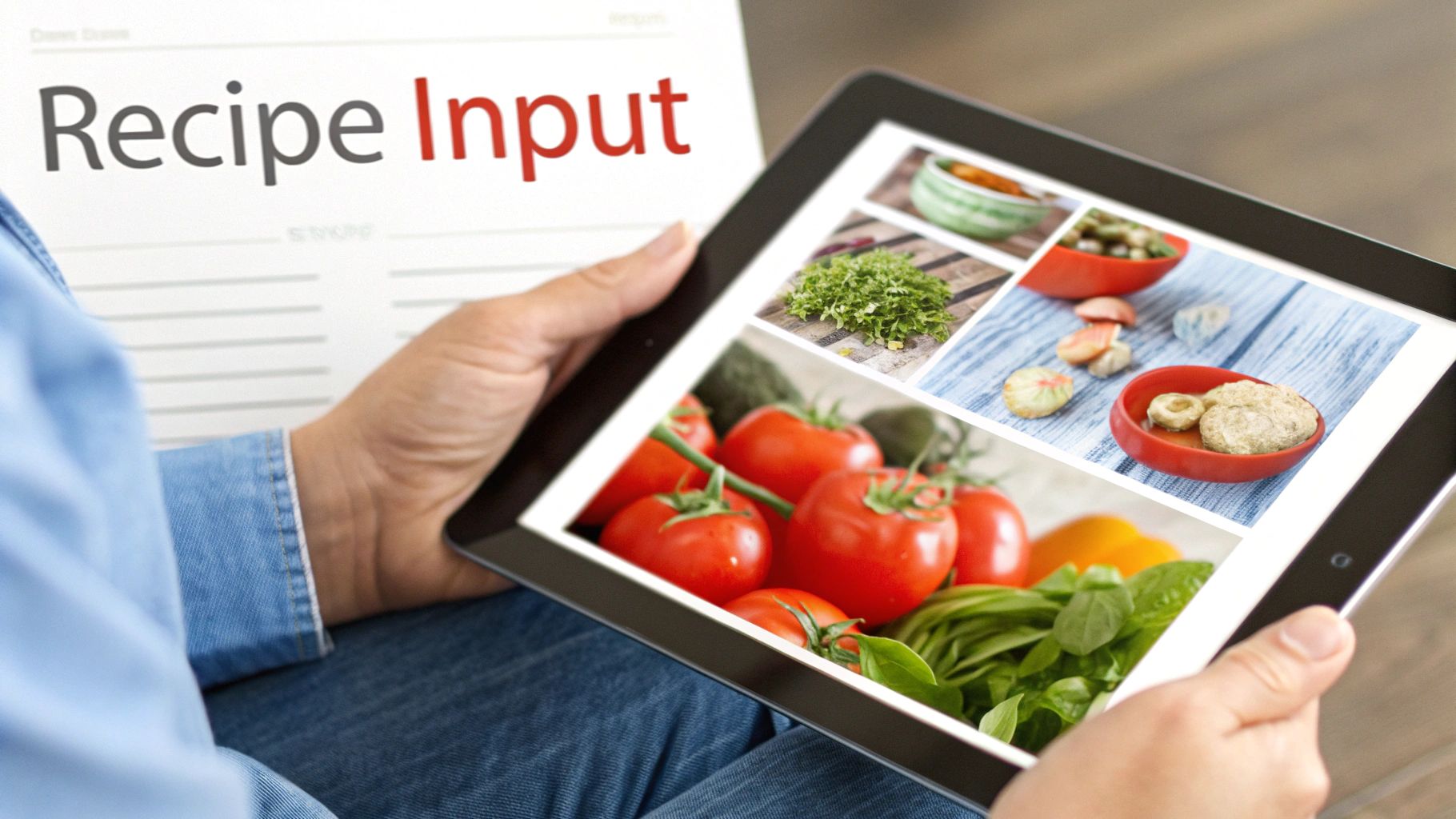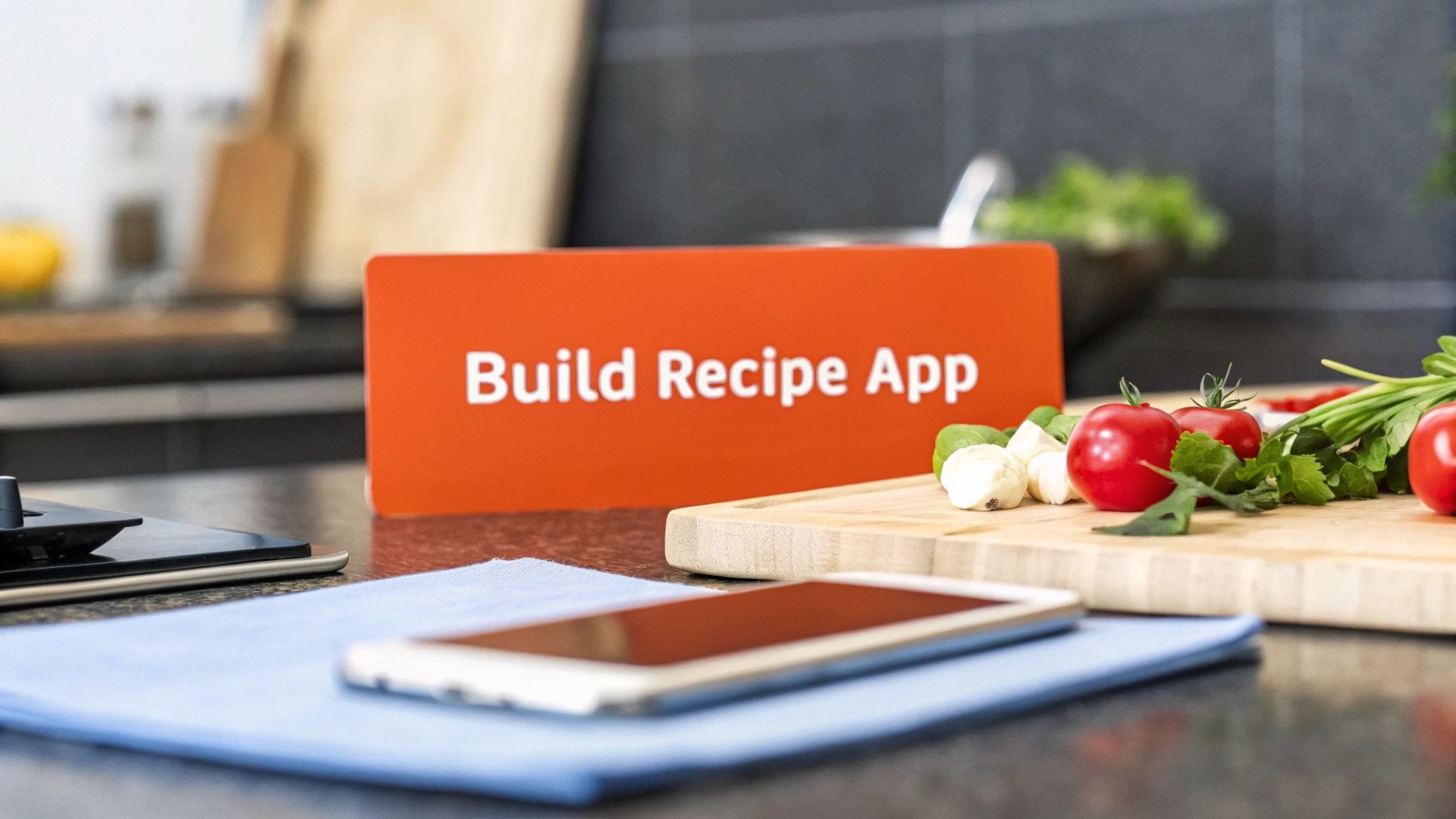Breaking Into the Recipe App Landscape

The recipe app market is a busy place, offering a wide variety of options for users. If you're thinking about developing a recipe app, it's important to understand this landscape. This means looking at current trends, figuring out what needs aren't being met, and understanding what makes an app successful.
Understanding the Current Market Dynamics
The recipe app market is growing significantly. This is mainly due to the increasing demand for meal-planning tools and the addition of features like personalized recommendations and connection to smart kitchen devices. For example, North America holds a large share of the market, showing the region's preference for digital cooking solutions. This growth creates both opportunities and challenges for new apps. The market has seen substantial growth, with varying valuations. According to Straits Research, the market, valued at $5.80 billion in 2024, is expected to reach $14.27 billion by 2033.
Identifying Opportunities for Differentiation
Even though the market is competitive, there are still opportunities for apps that offer something unique. This could mean focusing on specific diets, providing advanced search options, or integrating with other kitchen tech. Knowing how users behave is also key. This means studying how users find recipes, how they organize their cooking, and what features they value most.
Key Features Driving User Adoption
Several key features are encouraging people to use recipe apps. These include:
- Personalized Recommendations: AI-driven recommendations based on what users like and any dietary restrictions they have.
- Smart Kitchen Integration: Connecting with smart appliances and other kitchen devices for a smooth cooking process.
- Intuitive Search Functionality: Strong search features that can handle cooking terms and variations in ingredients.
- Meal Planning Tools: Features that help users plan meals, make grocery lists, and track their food inventory.
Building a Sustainable Business Model
There are more ways to make money from a recipe app than just advertising. Successful apps often use subscriptions, in-app purchases, or team up with food brands. Choosing the right approach depends on the target audience and the app's overall value. Creating a successful recipe app requires carefully considering market trends, user behavior, and important features. By giving users something truly valuable and standing out from the crowd, new apps can find their place in this expanding market.
Mapping Your Recipe App's Core Experience

What makes a recipe app truly indispensable? It all comes down to the core user experience. This involves careful planning and a deep understanding of how people actually cook and interact with digital tools in the kitchen. This section explores how to create a recipe app that users will not only find useful but will also genuinely love.
Defining Your Minimum Viable Product (MVP)
When developing a recipe app, starting with a Minimum Viable Product (MVP) is essential. This approach allows you to concentrate on the most important features first. Think of it like building a house: you lay the foundation before adding the finishing touches.
This focused approach lets you test your app with real users early in the development process. Gathering this valuable feedback is crucial for making informed decisions about future updates and enhancements.
Prioritizing Features for Real User Needs
Understanding your target audience is paramount. Are they busy professionals looking for quick and easy weeknight meals? Or are they experienced home cooks eager to explore more complex recipes and techniques?
Knowing your audience will help you prioritize features that truly cater to their needs. For instance, dietary filters are a must-have for users with specific dietary restrictions or preferences. Advanced search capabilities, on the other hand, might be more appealing to culinary adventurers.
Structuring Information Architecture
A good recipe app should mirror the actual cooking process. The flow from searching for a recipe to actively preparing it in the kitchen needs to be seamless and intuitive.
Think about the steps a cook takes, from selecting ingredients to following the recipe instructions. How can your app design simplify and enhance that experience? Clear, intuitive navigation is essential.
The app's information architecture should be structured like a well-organized kitchen, making it easy for users to find exactly what they need when they need it.
North America currently holds 35.7% of the global recipe app market share as of 2023. This is largely attributed to high smartphone penetration and a growing interest in dietary trends. Globally, the pandemic significantly boosted the use of these apps, with some seeing traffic increases between 30-50%. Find more detailed statistics here. This growth highlights the increasing role of recipe apps in our daily lives.
From MVP to Future Expansion
It's tempting to include a wide range of features from the outset, but this can lead to feature creep, complicating the development process and overwhelming users. Starting with your MVP establishes a strong foundation.
Once you have a loyal user base and have gathered user feedback, you can introduce more advanced features. This could include things like voice-guided cooking or AI-powered ingredient substitutions. This phased approach maintains a streamlined core experience while offering exciting new functionalities down the line.
Balancing Simplicity With Advanced Functionality
The key to a successful recipe app is finding the right balance between simplicity and advanced features. While essential features like search, recipe saving, and ingredient lists are crucial, consider future integration of more advanced tools.
Think of it like a chef's knife: a simple tool, yet incredibly versatile. The goal is to provide both ease of use for basic tasks and powerful options for more complex cooking endeavors.
Essential vs. Advanced Features
To illustrate the difference between essential and advanced features, the following table provides a comparison. It highlights the must-have functionalities for a Minimum Viable Product (MVP) and contrasts them with the advanced features that could enhance the user experience in future updates.
Essential vs. Advanced Recipe App Features
| Feature Category | Essential Features (MVP) | Advanced Features (Future Updates) |
|---|---|---|
| Recipe Search | Keyword search, filtering by category | AI-powered search, visual search, saved search filters |
| Recipe Management | Saving recipes, creating collections | Meal planning, grocery list integration, recipe editing |
| Cooking Mode | Step-by-step instructions, adjustable servings | Hands-free mode, voice control, timer integration |
| User Interaction | User accounts, ratings/reviews | Social sharing, comments, personalized recommendations |
This table provides a clear roadmap for developing your recipe app, starting with the core essentials and gradually expanding to offer a richer, more personalized experience.
By focusing on the core user experience, you create a recipe app that users will truly appreciate and return to time and again. Careful planning ensures your app becomes a practical and enjoyable tool for every cook, from beginner to expert.
Choosing Your Tech Stack With Confidence

Building a successful recipe app means creating a solid technological foundation. This involves choosing the right tools and technologies. These choices should support not just your initial launch, but also future growth and scalability. This decision affects development speed, performance, and ultimately, user satisfaction.
Frameworks For Performance and Scalability
Picking the right framework is crucial. Think of it like choosing the right oven for a bakery – it needs to handle the workload and produce consistent results. For mobile development, React Native is a popular choice. It offers cross-platform compatibility, allowing you to build for both iOS and Android from one codebase. This can speed up development and reduce costs.
However, native development, using Swift for iOS and Kotlin for Android, often offers better performance. This is especially true for complex features or interfaces that are visually intensive.
For the backend, consider Node.js with Express.js. This pairing enables fast development and efficient handling of real-time features, like user interactions and notifications. Cloud platforms, such as AWS or Google Cloud, offer scalable solutions for database hosting and server infrastructure management.
Handling Recipe Data and Media Assets
Recipe data needs structure. It should be both user-friendly and machine-readable. Imagine organizing a pantry – you need to find ingredients quickly. Databases like MongoDB or PostgreSQL can handle various data types. These include text ingredients, instructions, images, and videos.
Optimizing images and videos for faster loading times is key to preventing user frustration, particularly on mobile devices.
Backend Architecture and Search Functionality
A robust backend is essential for managing large amounts of recipe data and user requests. A microservices architecture can help. It breaks down your app into smaller, independent services, making it easier to manage, update, and scale your application as it grows.
Effective search functionality is also important. It should understand cooking terminology. Tools like Elasticsearch can provide powerful search capabilities. This lets users find recipes based on ingredients, cooking methods, or dietary restrictions.
Making Informed Decisions: A Framework Comparison
Choosing a tech stack isn't about chasing trends. It's about finding the right fit for your project. The table below compares popular development frameworks for recipe apps, highlighting their pros and cons. You can learn more about recipe management in our article, How to master recipe management. This comparison will help you find the framework that best aligns with your project goals and technical skills.
To help you in your decision-making process, we've compiled a comparison table:
Development Framework Comparison for Recipe Apps
| Framework | Learning Curve | Performance | Development Speed | Platform Support | Best For |
|---|---|---|---|---|---|
| React Native | Medium | Good | Fast | Cross-Platform | Apps prioritizing faster development cycles |
| Swift (iOS) | Medium | Excellent | Moderate | iOS only | Apps focused on iOS with high performance needs |
| Kotlin (Android) | Medium | Excellent | Moderate | Android only | Apps focused on Android with high performance needs |
| Flutter | Medium | Good | Fast | Cross-Platform | Apps requiring a visually rich user interface |
This table provides a helpful overview of the various technologies available for building your recipe app. Remember to consider your team's expertise, budget, and long-term goals when making your decision. Taking this informed approach will set your app up for success in the competitive recipe app market. You can also check out How to master recipe organization. Making smart choices about your tech stack creates a strong foundation for a user-friendly, scalable, and successful recipe app.
Building a Recipe Database Users Will Love

A successful recipe app depends heavily on its content. Think of it as a restaurant. Even with beautiful decor, bad food will drive customers away. This section explores building a recipe database that satisfies users and keeps them coming back.
Structuring Recipe Data for Real-World Cooking
Recipes are more than just ingredients and instructions. They need to work in real kitchens. This means considering things like ingredient substitutions, scaling recipes, and catering to different dietary needs.
For example, easily swapping chicken for tofu or adjusting serving sizes makes your app practical. This flexibility reflects how people cook, making your app a valuable kitchen tool. This adaptability also broadens your app's appeal.
Categorization and Tagging: Thinking Like a Cook
How you categorize and tag recipes significantly impacts discoverability. Traditional categories might not reflect how people think about food. Someone might search for "quick weeknight dinners" instead of "chicken dishes."
Using relevant tags and flexible search options helps users find recipes based on ingredients, time constraints, or dietary needs. This user-focused approach increases engagement and satisfaction.
Ethical and Legal Considerations: Respecting Creators
Building a recipe database has ethical and legal implications, especially around sourcing. Whether using original recipes, user submissions, or existing online sources, proper attribution is essential. This respects creators and builds trust with users.
Clearly stating each recipe's source is a best practice. Including links to the original source adds value for users and acknowledges creators. Transparency in sourcing builds integrity.
Ensuring Recipe Quality and Consistency
Consistent quality is key, regardless of the content source. This includes clear formatting, accurate measurements, and thorough instructions. A review process, whether by your team or trusted users, can test recipes before they go live.
This quality assurance builds a reputation for reliability and accuracy, crucial for any recipe app. Users will appreciate the effort put into making sure every recipe is a success.
Practical Approaches to Content Management
Managing a large recipe database requires organization. A Content Management System (CMS) allows you to efficiently add, edit, and organize recipes, ensuring quick updates and data accuracy.
A CMS simplifies tagging, categorizing, and formatting. This structure becomes vital as your collection grows, ensuring a consistent user experience. Think of a CMS as the head chef, ensuring smooth workflows and quality output.
By prioritizing these aspects, you build an app that stands out. It becomes a valuable, trusted cooking companion. Learn more about recipe organization with our blog post, How to Organize Recipes. This approach builds a loyal user base and sets your app up for continued success.
Designing an Interface Chefs Actually Use
Recipe apps aren't just digital cookbooks; they're vital kitchen companions. This means they face unique user experience (UX) challenges. They’re often used in less-than-ideal conditions—messy hands, varying lighting, and limited counter space. Building a truly successful recipe app hinges on designing an interface that works flawlessly in a bustling kitchen.
Considering the Real-World Cooking Environment
Picture this: you're covered in flour, trying to follow a recipe on your phone. The screen dims constantly, the text is tiny, and navigating requires multiple taps. Frustrating, right? Understanding the real-world cooking environment is paramount.
Key considerations include:
- Screen Visibility: The interface needs to be easily readable in various lighting conditions, from bright sunlight to dim kitchen lighting.
- Hands-Free Interaction: Voice commands and gesture controls allow cooks to navigate without touching their devices. Imagine using Amazon Alexa or similar technology right in your kitchen!
- Simple Navigation: Minimize taps and swipes. Large, clearly labeled buttons are essential for quick access.
Typography and Color Contrast for Clarity
Even the best recipe is useless if it's unreadable. Choosing the right typography and color contrast is vital. Font size should be adjustable, and the font should be clear and easy to read at a glance.
Sufficient color contrast between the text and background is essential for readability. For example, avoid light gray text on a white background. Test your app in different lighting to ensure optimal visibility.
Recipe Presentation: Balancing Visual Appeal and Functionality
Appealing food photography is enticing, but functionality is key. Recipe presentation requires balance. High-quality images or videos draw users in, but ingredients, instructions, and cooking times should always be prominent and accessible.
Consider separating visual elements from instructions. This allows users to focus on what they need at each stage of cooking. For more tips on managing your recipes, check out our guide on choosing the best recipe management app. A structured approach enhances usability.
User Testing for Recipe Apps: Gathering Meaningful Feedback
User testing is crucial, but recipe apps have specific needs. Test your app in real kitchens. Observe how users interact with it while cooking. Gather feedback on their experiences.
Focus your testing on key aspects of cooking. How easy is it to follow the recipe while multitasking? Are the instructions clear? Can users adjust serving sizes or substitute ingredients easily? This targeted approach provides valuable insights.
Accessibility: Designing for Everyone
Inclusivity is paramount. Consider users with visual impairments, motor limitations, or cognitive differences. Adjustable font sizes, alternative text for images, and screen reader support improve the experience for everyone.
Designing for accessibility enhances your app's inclusivity, welcoming all cooks. Focusing on these practical considerations builds a truly excellent recipe app. This transforms your app from a simple recipe repository into a valuable, user-friendly tool for any chef, making cooking more enjoyable.
Elevating Your App With Smart Features
Building a basic recipe app is a great starting point. But to truly stand out, you need smart features that address real user needs. These functionalities can transform a simple recipe collection into an indispensable cooking companion.
Personalization: Tailoring the Cooking Experience
Personalization is key for any app. It's about more than just saving favorite recipes. Think of Spotify, which creates personalized playlists based on your listening habits. A recipe app can learn user preferences, suggesting meals based on dietary restrictions, favorite cuisines, or even available ingredients.
This tailored approach enhances the cooking experience, making it easier for users to find new recipes they'll love. No more endless scrolling! Meal planning becomes a breeze, fostering user loyalty and encouraging repeat use.
AI Integration: Smart Cooking Assistance
AI offers exciting possibilities for recipe apps. Imagine features like ingredient recognition: users upload a photo of their pantry and receive recipe suggestions. AI can also power smart substitution suggestions, offering alternatives for missing ingredients.
However, thoughtful AI integration is crucial. The goal is to enhance, not overwhelm. Features should be intuitive and easy to use. For example, substitutions should be seamless, without complicated steps or confusing interfaces.
Social Features: Fostering Community
Social features can build a vibrant community around your app. Users can share recipes, comment on others' creations, and even collaborate on meal planning. This creates a sense of belonging and encourages interaction.
But privacy is paramount. Users should have complete control over their shared content. Offer clear privacy settings and transparent data usage policies. This builds trust and allows users to engage comfortably.
Integrating With Smart Kitchen Devices and Grocery Services
Integrating with smart kitchen appliances and grocery services creates a seamless cooking journey. Imagine sending a recipe directly to your smart oven or automatically adding ingredients to your online grocery cart.
This streamlines the entire cooking process, from planning to preparation. It's convenient and efficient, positioning your app as a central hub for all culinary needs.
Examples From Leading Apps
Many successful apps have integrated these smart features. Some offer personalized meal plans based on dietary needs. Others provide AI-powered ingredient substitutions. Studying these examples offers valuable insights.
Consider incorporating features like:
- Personalized recipe recommendations based on user activity and preferences.
- AI-powered ingredient substitution suggestions that consider dietary needs and common pantry items.
- Integration with smart kitchen devices for direct appliance control.
- Seamless grocery list creation and integration with online grocery platforms.
- Community features for sharing recipes and tips while respecting privacy.
By thoughtfully incorporating these smart features, your recipe app becomes more than just a recipe collection. It becomes a valuable tool that simplifies meal planning, enhances the cooking experience, and builds a community. This strategic approach fosters user loyalty and sets your app apart in a competitive market.
From Launch To Growth: Building Your Recipe Community
Launching your recipe app is a big step, but it's just the beginning. Growing a successful user base requires smart marketing and community engagement. This means understanding App Store Optimization (ASO), content marketing, and how to turn casual users into loyal fans.
App Store Optimization (ASO): Getting Discovered
Think of the app store as a busy marketplace. ASO is like setting up a shop window to attract customers. For recipe apps, this means:
- Keyword Optimization: Use relevant keywords in your app's title and description. Consider how people search for recipe apps. Do they search for "vegetarian recipes," "easy dinners," or "weekly meal planning"?
- Compelling Visuals: Your app icon and screenshots should look appealing and highlight your app's best features. Mouth-watering images of delicious food are key.
- Positive Reviews and Ratings: Encourage happy users to leave reviews. Respond to negative reviews quickly and professionally. Positive feedback builds trust and encourages downloads.
Content Marketing: Establishing Authority and Driving Organic Discovery
Content marketing is about creating helpful information that draws in your target audience. This could include:
- Blog Posts: Share cooking tips, recipe collections, or interviews with chefs. Check out this post for inspiration: How to master recipe organization. This type of content shows off your expertise and builds trust.
- Social Media Engagement: Share interesting content, run contests, and interact with your followers. This keeps your audience engaged and expands your reach. Consider platforms like Instagram and Facebook.
- Email Marketing: Send newsletters with special recipes, cooking tips, or app updates. This keeps users informed and coming back for more. Consider using a service like Mailchimp to manage your email campaigns.
Community Building: Turning Users into Advocates
A strong community transforms casual users into dedicated advocates. Here's how:
- In-App Interaction: Let users share recipes, comment on dishes, and connect with each other. This creates a sense of belonging and boosts engagement.
- Social Media Groups: Start a Facebook group or online forum where users can connect, share recipes, and ask questions. This builds a community beyond your app.
- Respond to Feedback: Actively seek out and respond to user feedback. This shows that you value their opinions and are working to improve the app.
Gathering and Implementing User Feedback
Feedback is vital for making your app better. Regularly collect feedback through surveys, in-app forms, or social media polls. Use this feedback to find areas for improvement and prioritize new features. For example, if users often ask for a specific feature, consider adding it to your development plans.
Monetization Strategies for Recipe Apps
Monetization should fit with how people use your app. Some options are:
- Freemium Model: Offer basic features free, and charge for premium features like advanced search filters or personalized meal plans.
- Subscription Model: Give access to all features for a regular fee.
- In-App Advertising: Show ads in your app, but be careful not to disrupt the user experience. Avoid annoying ads that interfere with cooking.
- Partnerships: Team up with food brands or kitchen appliance companies.
By focusing on these strategies, you can build a thriving community around your recipe app, turning users into loyal fans and driving growth. Download Recify now and start organizing your recipes today! Recify is a great tool for managing your culinary creations.
